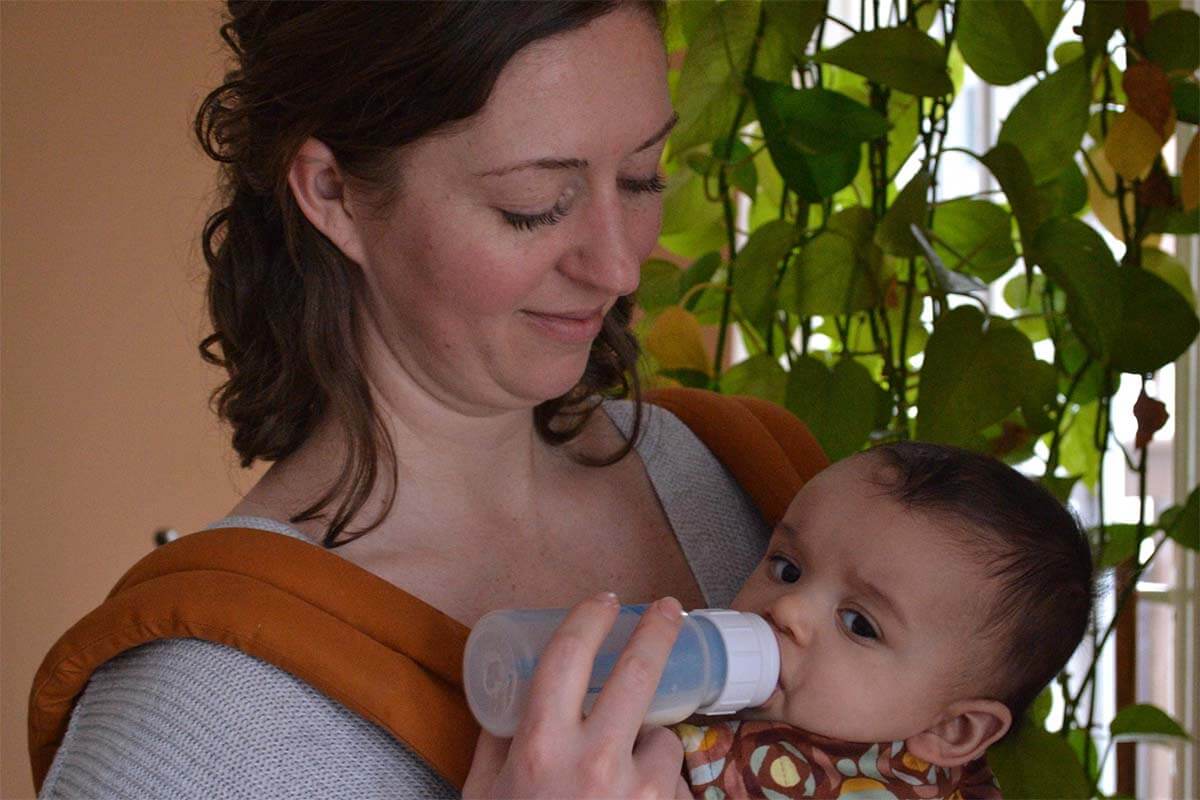Some babies easily accept the bottle and may go back and forth between it and the breast with no issues. Other babies take a little more convincing, especially as they get older. A baby will almost always prefer what is natural and familiar, not to mention that there can never be a perfect substitute for the breast! Many parents, already anxious about returning to work, become frantic when they find their baby won’t take a bottle.
If you plan on returning to work or having regular periods of separation from your baby, I recommend offering your baby a bottle every few days, starting at around 4-6 weeks of age (assuming latching and feeding at the breast are well established). Parents returning to work earlier than this time period may need to introduce the bottle a week or so before returning to work. Babies younger than two months of age are often more willing. However, introducing a bottle too early may cause confusion for a baby who is still learning to latch and remove milk from the breast. Frequent bottles early on may also interfere with establishing the parent’s milk supply.
Before introducing a bottle, learning “baby-led” bottle-feeding techniques, also known as “cue feeding” can help prevent overfeeding and reduce nipple confusion. Bottles have a fast flow and are not nearly as much work as breastfeeding. Babies can become accustomed to the ease of feeding with a bottle and start to refuse the breast. It is also very easy to overfeed a baby with a bottle. When caregivers overfeed breastfed babies, the babies nurse less when they are with their parent, which can compromise milk supply. Using baby-led bottle-feeding techniques can help prevent these issues.

If a baby is resistant to drinking from a bottle, it is most important to stay calm, keep the baby calm, and keep trying. The following suggestions may be helpful.
- Anything normally done to calm the baby may help. Walking, swaddling, bouncing on an exercise ball, listening to music or white noise, singing, talking to baby, or even making a trip outside while offering the bottle are a few ideas. For some babies, distraction seems to help. For other babies, creating a calm, quiet atmosphere works better. A baby may even be more willing to accept a bottle when they are very sleepy.
- If the baby becomes upset during bottle-feeding, try again later. Just like in the early days of breastfeeding, calm babies feed better.
- Allow time for the baby to become familiar with the bottle. Let the baby see and play with the bottle a few times when it is empty and a feeding isn’t being attempted.
- In choosing a bottle, the flow and shape of the nipple are the most important considerations. It’s important to find a bottle that is slow flow (not just advertised as such), that allows your baby a wide latch on the nipple. Don’t fall for marketing hype. Often bottles advertised as more like the breast are some of the worst options! Also, don’t feel the need to try multiple bottles and nipples. Trying a couple different bottles is fine, but it is best to stick with one system, so the baby can become familiar with it. If a recommendation for a bottle nipple is needed, please discuss individual needs with a lactation consultant.
- It might be best to have the lactating parent attempt to introduce the bottle, since babies relate the parent to their food source. However, some babies are more willing to take a bottle if their preferred source of food isn’t right next to them. It might even help for the lactating parent to be in a different room or out of the house.
- Hold the baby in different positions. Some babies prefer facing in, more like breastfeeding, and some prefer facing out. Some babies prefer to bottle feed while lying on their side, as they are when they breastfeed.
- Place the bottle nipple in warm water or breastmilk before offering it to the baby.
- Offer the bottle in between expected feeding times when the baby is ready to accept food, but not so hungry he/she doesn’t have patience for something new.
- Offer the bottle during a time of day the baby is normally happiest.
- Try to feel positive and relaxed about the use of a bottle. Babies are smart and pick up on the anxious feelings of others, especially their parents! If a caregiver is feeling anxious about offering a bottle, the baby will also.
- Offer small amounts of milk (1/4 -1/2 oz) at first so the baby does not become frustrated. This also prevents wasting larger amounts of milk if the baby doesn’t accept the bottle.
- Try nursing a little and then immediately offering the bottle. If the baby takes a pacifier, try offering the pacifier for a few minutes and then the bottle.
Something different will work for every baby. A calm caregiver and a calm baby, along with a little patience, will most likely lead to bottle-feeding success!
There are also options to feed a baby other than a bottle during separation from the parent. Some babies eat very little during these times and make up for it other times. Parents may be able to nurse their baby immediately before leaving and immediately after returning. For parents who work full time, nursing during a lunch hour may be an option. Babies also may begin to wake to nurse at night more frequently when they are away from their parents during the day. In these cases, bed sharing, while following safety guidelines, may be a great option. During separation, babies also may be fed milk with a syringe or a cup. With practice, even very young babies can learn to drink from a cup.
Babies don’t just choose to make life difficult for parents. There is always an underlying reason if a baby won’t take a bottle. These may include a suck/swallow/breath dysfunction, a tongue tie, a sensitive gag reflex, or various other issues. If you have tried the above options and your baby is still struggling to take a bottle, please seek the help of a lactation consultant for individualized support.




